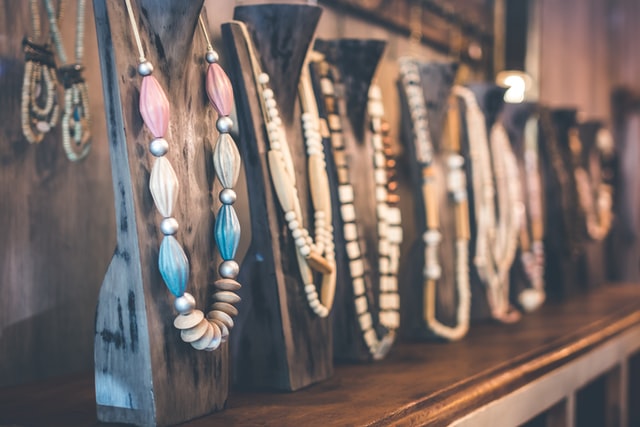

Every look is incomplete without pairing it with proper accessories. Have you ever wondered how the necklaces, earrings, bracelets and other precious jewellery are made? Do you ever want to create your own personalised jewellery pieces? Jewellery making is not just a simple art, there are many techniques involved in making it. Making your own jewellery can save you a substantial amount of money. Here is an ultimate guide to how jewellery is made:
Jewellery is one of the oldest archeological artefacts. The first pieces of jewellery making was found in Africa over 75000 years ago. These were made from shells and ostrich egg shells back then. In 3000 BC, gold started being used as a raw material for making jewellery in Egypt. In ancient times, jewellery was made from raw materials like metals, bones, stones, and other lustrous materials. Jewellery making was a time-consuming process back then, and the craftsmen spent hours and days hammering, cutting and designing the jewellery pieces. Jewellery making involved several intricate techniques.
Filigree technique is when metals like silver, gold and copper are being heated and poured into small holes to give it a shape like thin wires. The craftsmen then fold these wires to give it a desired shape and size and create different types of patterns. It was a very popular technique in the 1920s. It was a very time-consuming process and required a lot of patience.
In this technique, small pieces of glass are cut and inserted into metal compartments. These metals are then heated to give it a bright colour. This technique is quite popular in China and Japan and the jewellery pieces made out of this technique are very expensive.
Lost wax casting process is when jewellery pieces are made out of wax. Firstly, a wax figurine is designed. This figurine is then covered with clay and is heated so that the clay gets hard. The hot wax is then poured out and molten metal is poured in. Gold or silver are often used to cast this type of jewellery.This technique is one of the easiest and affordable jewellery making techniques.
With technology taking over almost every sector across the world, the jewellery making sector is no different. In the modern day world, jewellery is made using technically advanced and sophisticated tools. Despite the technical advancements in the field of jewellery making, creativity, visualisation and artistic skills are still essential. Jewellery making is still a complicated and time taking process.
Let us look at the steps involved in jewellery making:
The first step of jewellery making is visualising its design. Jewellery designers are in charge of creating unique and exquisite jewellery designs based on the instructions provided by the jewellery makers. Only when the jewellery design is approved, the production process will begin.
Jewellery making consists of different techniques. Several jewellery artists collectively work on making a piece of designer jewellery. Each artist is assigned a specific task to do according to his area of expertise. Jewellery molding is a vital part of jewellery making as the end result depends on this mold. The different types of tools used to make a piece of jewellery are:
There are several techniques used in jewellery making. The most commonly used techniques are:
Jewellery knotting: while making jewellery out of beads, knotting techniques can be used to hold the beats together for a longer time. Craftsmen make different types of knots depending upon the type of thread and beats used.
Jewellery looms: jewellery looms are used to join beads more quickly. Different colour and shapes of beads can be joined together in geometrical patterns to give the jewellery an unique and interesting look.
Jewellery strings: It is not so simple to put beads into a thin wire or string. Craftsmen work with lot of precision and patience while doing this task. It is one of the core skills used for jewellery making.
Jewellery molding: Molding is an vital part of jewellery making process as the end result usually depends on the mold. Rubber, silicon and wax are some of the affordable materials that can be used as a mold. Metal like silver, gold or some of the expensive molds used in jewellery making.
Jewellery embellishment: precious stones of different sizes and weights are used to enhance the beauty of the jewellery. The most skilled and experienced craftsmen are assigned to set the stones into the cast as it is a very time consuming and intricate task and The setting process requires a lot of patience and a steady hand.
Jewellery polishing: The jewellery pieces are then carefully polished and cleaned to achieve shine and to smoothen the surface. It is also important to get rid of the sharp edges of the metal so that it can be safe and ready to wear. Polishing materials vary for different metals.
Jewellery plating: It is the last step of jewellery making. After the jewellery is polished, the plating experts use electro deposition of rhodium, copper, gold, silver or any other metal . This process ensures the durability of the jewellery.
o Raw materials used, their shipping and delivery costs
o Selling costs
o Shipping costs
o Packaging costs
o Marketing, promoting and branding costs
o Opportunity costs
o Market demand
o Income of the consumers
Fashion trends change every now and then but many people cannot keep up with the changing fashion trends due to the lack of sufficient income. It is not necessary to buy different pieces of jewellery just for the sake of staying up to date with the fashion trends. It is okay to invest in one exquisite jewellery and stand out from the crowd. While buying jewellery, research is the must. It is important to know the worth of the jewellery and its value in the fashion world.